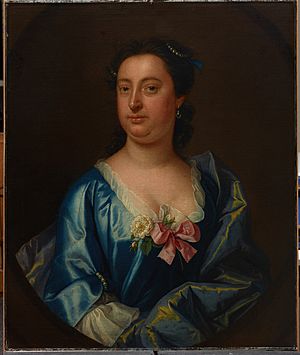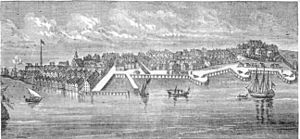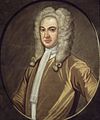Edward Hyde, 3rd Earl of Clarendon facts for kids
Quick facts for kids
The Earl of Clarendon
|
|
|---|---|
 |
|
| 1st Governor of New Jersey in British North America |
|
| In office 1701–1708 |
|
| Monarch | Anne |
| Lieutenant | Col. Richard Ingoldesby Lieutenant-Governor |
| Preceded by | Office created |
| Succeeded by | John, 4th Baron Lovelace |
| 14th colonial Governor of New York | |
| In office 1702–1708 |
|
| Monarch | Anne |
| Preceded by | John Nanfan |
| Succeeded by | John, 4th Baron Lovelace |
| Personal details | |
| Born |
The Hon. Edward Hyde
28 November 1661 England |
| Died | 31 March 1723 (aged 61) Chelsea, London, England |
| Resting place | Westminster Abbey |
| Political party | Tory |
| Spouses | Katherine O'Brien, 8th Baroness Clifton |
| Children | Edward, 9th Baron Clifton; Catherine; Mary; Flora; Theodosia; 10th Baroness Clifton |
| Parents | Henry Hyde, 2nd Earl of Clarendon Theodosia Capell |
| Alma mater | Christ Church, Oxford |
| Profession | Diplomat and governor in British North America |
| Signature |  |
Edward Hyde, 3rd Earl of Clarendon (born November 28, 1661 – died March 31, 1723), also known as Lord Cornbury, was an important English politician and aristocrat. He became famous during the Glorious Revolution of 1688. This was when he and some of his army switched sides from King James II to support William III of Orange.
Later, Lord Cornbury became the governor of the provinces of New York and New Jersey. He served from 1701 to 1708. His main job was to protect the colonies during a big war called the War of the Spanish Succession (also known as Queen Anne's War in America). He successfully stopped French attacks on the middle colonies. However, he faced many disagreements and made powerful political enemies.
By 1708, Lord Cornbury was called back to England. He then became a member of Queen Anne's special council. When George I became King in 1714, Lord Cornbury lost his favor. He died in Chelsea, London, in 1723.
Lord Cornbury's time as governor is often remembered for facing many accusations. He was accused by his political rivals of mismanaging money and being unfair.
Contents
Who Was Edward Hyde?
Edward Hyde was born on November 28, 1661. He was the only child of Henry Hyde, 2nd Earl of Clarendon and Theodosia Capell. His mother died of smallpox just three months after he was born.
His Family's Royal Connections
The Hyde family had strong ties to the English monarchy. Edward's grandfather, also named Edward, was the 1st Earl of Clarendon. He was a key advisor to King Charles I and King Charles II. He helped bring the English monarchy back in 1660.
Edward's aunt, Anne Hyde, married James, Duke of York, who later became King James II. Anne was also the mother of two future English Queens: Mary II and Anne. This made Edward Hyde a first cousin to Queen Anne.
Education and Early Career
At 13, Edward started studying at Christ Church, Oxford. A year before that, he became Viscount Cornbury when his father became the 2nd Earl of Clarendon. After Oxford, he studied in Geneva for three years.
Military Service and the Glorious Revolution
After finishing his studies, Lord Cornbury joined the Royal Regiment of Dragoons. This was an elite army unit led by John Churchill. By 1683, he was a lieutenant colonel.
The Monmouth Rebellion
In 1685, King Charles II died. His brother, James II, became king. James was Catholic, which caused problems in mostly Protestant England. James Scott, the Duke of Monmouth, who was Protestant, tried to claim the throne. This led to the Monmouth Rebellion.
Lord Cornbury was promoted to lead the Royal Dragoons. His unit helped quickly stop the rebellion. As a reward, he became a member of Parliament.
Cornbury's Role in the Glorious Revolution
Lord Cornbury played a very important part in the Glorious Revolution. He was the first English officer to switch sides and support William III of Orange.
In 1688, some English nobles invited William of Orange to come to England. William arrived with a large fleet and army in November. Cornbury's Dragoons were the first royal army unit to meet William's forces. Soon after, Lord Cornbury joined William's side, bringing some of his soldiers with him. Four days later, his mentor, Lord Churchill, also switched sides. Even though only a small number of Cornbury's men joined him, his actions greatly hurt the King's morale.
By December, King James had fled to France. Parliament then decided that William would rule as King. Lord Cornbury had wanted his cousin, Queen Anne, to be next in line after Mary. This made William see Cornbury as disloyal. As a result, Cornbury was removed from his army position and other royal roles.
Life After the Revolution
After losing his positions, Lord Cornbury faced financial difficulties. He was a noble, so he couldn't just get a regular job. He needed income from royal or political roles. He struggled for several years. However, he continued to serve in Parliament.
In 1698, King William agreed to pay Cornbury a weekly sum, which helped his finances. In 1701, William rewarded Cornbury's continued support by appointing him Governor of New York.
William died before Cornbury became governor. The crown then went to Queen Anne, Cornbury's cousin. Because Cornbury had supported her for the throne earlier, Queen Anne continued to support him. She would later reward him generously.
Governor of New York and New Jersey
Lord Cornbury arrived in New York on May 3, 1702, to begin his job as governor. He was welcomed by the local leaders. He became governor during Queen Anne's War, which was a threat to the colonies. He was also made "captain-general of all forces by sea and land" for all colonies north of Virginia.
Protecting the Colonies
When he arrived, Governor Cornbury checked the colony's defensive forts. He found them in very bad condition. The main fort in Albany was almost unusable. He immediately started a big project to build a new stone fortress, later called Fort Frederick. This project was important for protecting the colony.
In August 1703, the new Province of New Jersey was also added to Cornbury's responsibilities by Queen Anne.
The other threat to New York was attack by sea. The entrance to New York harbor was protected by Fort William Henry. There were also forts and defenses along the Hudson River. In 1706, a French ship appeared near the harbor. This caused a panic, but the ship sailed away without attacking. No French or Native American attacks happened in New York Colony during the 11-year war.
Challenges and Accusations
The New York Assembly had given money to finish harbor defenses. However, blame was quickly put on Governor Cornbury, with accusations that he had misused the money. Because of this, the New York Assembly stopped giving money to the governor and decided to manage the colonial budget themselves.
Lord Cornbury also faced challenges regarding religion. He wanted the Church of England to be the main religion in the colonies. He was surprised to find that public money had been used for a Presbyterian church on Long Island. In 1704, this church and its buildings were taken over for use by the Anglican Church.
A famous incident involved Reverend Francis Makemie, a Presbyterian minister. In 1707, Makemie held a worship service and baptized a baby in a private home in New York. This was against English laws that limited "dissenter" religions. Governor Cornbury had the minister arrested for preaching without a license. Makemie was later found not guilty, but the governor ordered him to pay all the trial costs.
During this time, Cornbury often disagreed with Lewis Morris, a member of the New Jersey Provincial Council. Cornbury suspended Morris from the council twice.
Despite these issues, the Anglican Church grew. Trinity Church in New York had opened in 1698. In 1705, Governor Cornbury and Lewis Morris helped add land to Trinity Church's holdings. This land was planned for a new college, which later became Columbia University.
End of His Time as Governor
In 1708, Governor Cornbury was called back to England. The government believed he had not been active enough militarily. They also thought he would not be able to get the necessary money from the colonial assembly.
After Being Governor
In December 1708, Lord Cornbury was put under house arrest in New York City because of unpaid debts. Since 1705, the New York and New Jersey Assemblies had refused to pay the governor's salary. This meant Cornbury had to borrow money, leading to large debts.
His luck changed when his father died in 1709. This made him an Earl, which gave him special protection against civil lawsuits. This freed him from debtors' prison. When he returned to England, Queen Anne gave him a pension and a place to live in a royal palace. He also joined the government as a commissioner of the admiralty in 1711.
Queen Anne sent Cornbury as a special messenger to her successor, George, Elector of Hanover. Cornbury spent time with the royal family. However, when King George I became King of Britain, he did not favor the Tory party, which Cornbury belonged to. Cornbury lost his position as an emissary. He continued to be active in the House of Lords until about 1720. He died on March 31, 1723, in Chelsea, London, and was buried in Westminster Abbey.
How History Remembers Lord Cornbury
Lord Cornbury has often been remembered in a negative way by historians. He is sometimes seen as an example of the problems colonists faced under British rule. Some writers have suggested his actions contributed to the American Revolution.
Accusations of Misconduct
Many criticisms of Lord Cornbury come from complaints written in 1706 by Lewis Morris and Samuel Jennings from the New Jersey Assembly. The New York Assembly also sent a similar letter in 1708. These complaints included:
- Trying to have too much power over the local assemblies.
- Being accused of taking bribes.
- Accusations of misusing money meant for defense.
- Poor financial management, leading to large debts.
These kinds of complaints were common for governors during that time. However, one unique accusation against Governor Cornbury was about his personal style.
A story from a generation later, told by writer Horace Walpole, claimed that Lord Cornbury sometimes dressed in women's clothes. Walpole said that Cornbury explained this by saying he represented Queen Anne, a woman, and wanted to represent her as faithfully as possible. Another person, George James Williams, said his father had seen Cornbury dressed this way.
Lord Cornbury's Family
Lord Cornbury married Katherine O'Brien, the 8th Baroness Clifton, in 1685. She died in New York in 1706 at age 33 and was buried at Trinity Church.
Their children included:
- Catherine Hyde (died young)
- Mary Hyde (died 1697)
- Edward Hyde, Viscount Cornbury (1691–1713), died unmarried at age 22.
- Theodosia Hyde, 10th Baroness Clifton (1695–1722), married John Bligh, the 1st Earl of Darnley. She died at age 26.
Portraits of Lord Cornbury
There are no confirmed portraits of Lord Cornbury from his lifetime. An 18th-century portrait at the New-York Historical Society was thought to be Governor Cornbury wearing a dress. However, some art historians disagree.
The Dallas Museum of Art has another portrait, also believed to be Lord Cornbury in a Dress, painted between 1705 and 1750.
Lord Cornbury in Books and Plays
Lord Cornbury has appeared in various works of popular culture:
- Androboros, a play written by Robert Hunter (who became governor after Cornbury), made fun of important New York citizens, including Lord Cornbury. This play was one of the first written and published in the American colonies.
- He was the main character in the play Cornbury: The Queen's Governor, first performed in 1976.
- He also appears in Edward Rutherfurd's novel New York, Daniel Pinkwater's "The Adventures of a Cat-Whiskered Girl", and Robert McCammon's "Matthew Corbett" series of novels.
Images for kids
-
Lewis Morris, a political rival of Lord Cornbury
Category:Colonial governors of New JerseyCategory:Governors of the Province of New YorkCategory:Earls of Clarendon (1661 creation)Category:1st The Royal Dragoons officersCategory:English army officersCategory:Pages of HonourCategory:Hyde family (English aristocracy)Category:People from Swallowfield
 |
This category can be found at Category:People buried in Westminster Abbey.
Note: This category page should be empty. Any articles in this category should be moved to Category:People buried in Westminster Abbey. |
| 1660s births: | 1660-1661-1662-1663-1664-1665-1666-1667-1668-1669 |
This category has articles on people who were born in the year 1661.
See also: 1661 deaths.
| 1720s deaths: | 1720-1721-1722-1723-1724-1725-1726-1727-1728-1729 |
This category has articles on people who died in the year 1723.
See also: 1723 births.
Category:17th-century AnglicansCategory:18th-century AnglicansCategory:17th-century LGBT peopleCategory:Younger sons of earlsCategory:English MPs 1685–1687Category:English MPs 1689–1690Category:English MPs 1690–1695Category:English MPs 1695–1698Category:English MPs 1698–1700Category:English MPs 1701Category:18th-century diplomatsCategory:Alumni of Christ Church, OxfordCategory:British colonelsCategory:Members of the Parliament of England (pre-1707) for Wiltshire
See also
 In Spanish: Edward Hyde (gobernador de Nueva York) para niños
In Spanish: Edward Hyde (gobernador de Nueva York) para niños





